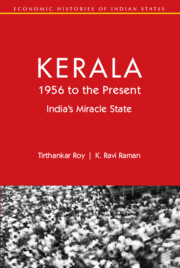Book contents
9 - Conclusion
Published online by Cambridge University Press: 31 May 2024
Summary
Kerala Is Different … Not the Way You Think
The book began with a one-liner – ‘Kerala is different’. The series to which this book belongs emerged from the intuition that every state in India ‘is different’. Kerala was not more different than Tamil Nadu, Gujarat or West Bengal. Geography and resource endowments, social conditions such as patterns of inequality, politics and markets were significantly dissimilar between the larger Indian states, and sometimes between regions within these states. Scholars doing development or history have not explored the differences enough.
And yet that shallow slogan has had an unparalleled impact on development discourse in the late twentieth century. Why has this one state drawn so much attention in the development scholarship? Because of a misreading of its economic history, the book argues.
As we mentioned in the introduction, the state's economic trajectory can be summed up, if crudely, with a chart with three lines, one measuring economic growth and the other two education and life expectancy. The state's position relative to India fell with the social indices but dramatically improved with economic growth. A preoccupation with social development lacks a strong justification, at least for economic historians of the state. The more challenging task for us was explaining the economic growth divergence with reference to prehistory and the state's geography.
The misreading emerged in the 1980s through an overstatement of human development performance. Many scholars inferred that the state's political ideology was more enlightened and developmental than that of other Indian provinces and that the state government's heart was in the right place. Whether due to the communist movement or Travancore and Cochin's princely heritage, the governments prioritised poor people's access to primary education and healthcare. Others further claimed that the state showed the world that economic growth was not needed for development.
This reading is not wrong. But, historically speaking, it is a naive reading. It is naive for three reasons. First, suppose Kerala was ahead of India in the 1950s and 1960s. In that case, a story of enlightened government does not make much sense because governments were relatively small then, and many factors besides the government were at work behind the initial advances in education and health.
- Type
- Chapter
- Information
- Kerala, 1956 to the PresentIndia's Miracle State, pp. 144 - 149Publisher: Cambridge University PressPrint publication year: 2024

